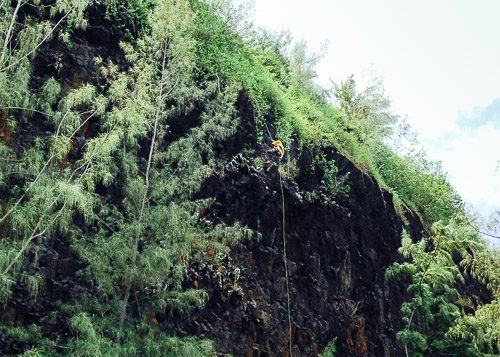Field Operations
Hawaiʻi Ant Lab’s (HAL) field operations crew focuses on surveying ports of entry (airports and seaports), green waste facilities, nurseries, and other high risk areas for invasive ant species, as well as participates in Little Fire Ant (LFA) eradication efforts throughout the State. Preventing the establishment of invasive species and detecting incipient populations before they have an opportunity to spread are the most cost-effective approaches to invasive species management. This is especially so for invasive ant species such as LFA which are difficult to detect in infested cargo and spread rapidly once established.
Our surveillance programs target not only LFA, but also the detection of new invasive ant species that would pose a serious threat to Hawaiʻi if established. Target high risk species not yet present include the Tawny Crazy Ant (Nylanderia fulva), European Fire Ant (Myrmica rubra), and Carpenter Ant (Camponotus spp.). Of all the potential invasive ant species invaders, the red imported fire ant (Solenopsis invicta or RIFA) poses the most
immediate and obvious threat to Hawaiʻi. RIFA are native to South America and so our climate would provide an ideal habitat for this species to thrive. In areas of the Southern USA where RIFA have invaded, it has caused disastrous economic and ecological impacts. RIFA look very similar to a fire ant species already present in Hawaiʻi, the Tropical Fire Ant (Solenopsis geminata), but RIFA are far more aggressive and dangerous. When a nest of RIFA are disturbed, large numbers of ants will swarm to repeatedly bite and sting the intruder, threatening the health of humans and animals. Because RIFA have established in California, RIFA poses an immediate threat of an invasion to Hawaiʻi due to the high volume of trade with California.
Our surveys are important to help with early detection, but we also rely on residents to survey and report suspicious ants in their own backyards. Any ants may be submitted to our office for identification. Read the UH-CTHAR Red Imported Fire Ant Publication for more information.
Surveying Efforts
Airport & Seaports

We conduct general surveillance ant surveys at airports and seaports across the State to prevent, detect, and manage the incursion of invasive ants and prevent the spread of LFA to other islands.
Green Waste Facilities

We survey the mulch piles for LFA at the Hilo, Kealakehe, and Puʻuanahulu green waste facilities on Hawaiʻi Island to mitigate the risk of spreading LFA through the movement of mulch.
Plant Nurseries

An infestation in a plant nursery provides the most damaging pathway for the spread of LFA, as every potted plant sold by the vendor becomes a vector for new infestations. Our Oʻahu staff surveys nurseries as part of our ongoing early detection and prevention activities on Oʻahu.
Eradication Efforts
Oʻahu

Thanks to the vigilance of residents surveying their homes for LFA, our Oʻ‘ahu HAL staff in collaboration with the Hawaiʻi Department of Agriculture, Oʻahu Invasive Species Committee, Coordinating Group on Alien Pest Species, and other agencies has been quite busy with eradication efforts of neighborhood infestations. Go to http://stoptheant.org/lfa-on-oahu/ for the current status of infestations on Oʻahu.
Maui

HAL is currently assisting the Maui Invasive Species Committee with a massive 150 acre infestation eradication in Nahiku, first detected in 2014. Because of the steep terrain and dense vegetation, the site is being treated through the first ever aerial application of HAL Gel Bait. Go to http://stoptheant.org/lfa-on-maui/ for the current status of infestations on Maui.
Kauaiʻi

In 2012, through a multi-agency response with contributions from the Kauaʻi Invasive Species Committee, Hawai’i Department of Agriculture, County of Kauaʻi, Climb Aloha and many others, HAL embarked in its most ambitious eradication effort of a 12 acre LFA infestation in Kalihiwai. To tackle the infestation, the field crew had the difficult task of having to rappel down a vertical 140ft cliff! The site will continue to be monitored on a yearly basis. Go to http://stoptheant.org/lfa-on-Kauai/ for the current status of infestations on Kauaʻi.
Pacific Ant Program
The Pacific Ant Program (PAP) is a project funded by the United States Forest Service (USFS) and was carried out by the Division of Forestry and Wildlife, Hawaiʻi (DOFAW), and the Pacific Cooperative Studies Unit of the University of Hawaiʻi (PCSU). The aim of the program is to provide useful information relating to prevention, surveillance, identification, and management of invasive ants in the Republic of Palau, Federated States of Micronesia, Commonwealth of the Northern Mariana Islands, and Hawaiʻi. Visit our Pacific Ant Program page to access the ant taxonomy and survey manuals developed for the program.
